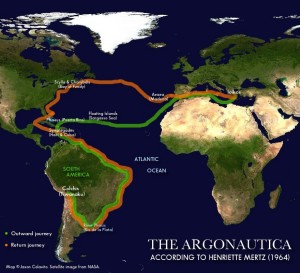Seven Cities
Peter Martyr d’Anghiera
Peter Martyr d’Anghiera, (1457-1526), was chaplain to the court of King Ferdinand II of Aragon and Queen Isabella I of Castile. In 1493 he claimed Hispaniola and the nearby islands were Antillae insulae, which he associated with the legend of the Isle of the Seven Cities.
Andrew Collins noted in Gateway to Atlantis [72.185] that “All the evidence points towards the fact that the legends surrounding Antillia and the Seven Cities predate the exploration of the Western Ocean during the age of discovery by many hundreds, if not thousands, of years.” Collins then proceeded to investigate the “true origins behind the story of Antilia and its legendary Seven Cities.”
Seven Cities of Antilia, The
The Seven Cities of Antilia are legendary cities reputed to have existed on the island of Antilia situated somewhere in the Atlantic. Medieval cartographers show Antilia (with a variety of spellings) at different locations in that ocean. Belief in its existence was firmly established by the time of Christopher Columbus. His son, Ferdinand, wrote of the many attempts to find it[1536].
For a time it had been thought by some that the Azores was location of Antilia, while Zhirov who believed the Island of the Seven Cities had some association with the North Atlantic Ridge[p.257].
In the early 20th century geographer, W. H. Babcock, identified Cuba as Antilia, while later in 2000, Andrew Collins, in his Gateway to Atlantis[072] devoted two chapters to the subject of the Seven Cities and also concluded that Cuba was its most likely location and by extension was also the home of Atlantis.
Antilia
Antilia (Antillia), according to Aristotle, was the name by which a large island in the Atlantic was known to the Carthaginians. It may be worth noting that in Portuguese the word, ante-ihla, can be translated as ‘before’ or ‘in front of the island’. Aristotle, who had been one of Plato’s students, was the first to criticize his story of Atlantis. However it was Aristotle who wrote of a huge island in the Atlantic Ocean known by the Phoenicians as “Antilia” and so he appears to have unwittingly ended up supporting Plato‘s story.
Antilia is also the name of a landmass shown on medieval charts, varying in size and location between the Azores/Canaries and the Caribbean. In 1474, Paulo Toscanelli (1397-1482) produced a chart(a) showing the island of Antilia in the mid-Atlantic due west of the Canaries. The same map also includes the mythical St. Brendan’s Isle as a larger landmass further south. Battista Boccario shows Antilia on a 1435 map as did Zuane Pizzigani a decade earlier. After the discovery of the West Indies it assumed its present plural form of ‘Antilles’ to describe the large archipelago there.
In 1492, Martin Behaim (1436-1507) a German geographer constructed the earliest globe that we still have today. On it he depicts ‘Insula Antilia Septa Citida’ [The Island of Antilia of the Seven Cities] with an associated comment that relates how in 734 AD after the Moorish invasion of Spain the archbishop of Porto with six other bishops occupied this island. The legend of the Seven Cities was widely recorded, but its exact location is shown on old, and often not totally reliable, charts, as ranging from the Azores to the West Indies.
William H. Babcock writing in the 1920’s[071] firmly opted for Cuba as Antilia, but was rather sceptical about the existence of Atlantis. On the other hand a more recent writer, Andrew Collins, is convinced[072] that Cuba had been home to Atlantis.
Lewis Spence, writing in the 1920’s suggested that Antilia was a land bridge between Atlantis and the Americas. He proposed that refugees fleeing from a sinking Atlantis used this land bridge from the centre of the Atlantic and headed for what is today the Yucatan peninsula.
‘Antilia’ is also the name given to what is reputed to be the world’s first billion dollar residence. It is located in Mumbai and is the home of the Indian billionaire Mr Mukesh Ambani.
(a) https://es.wikipedia.org/wiki/Archivo:Toscanelli_map.jpg
Mertz, Henriette
Henriette Mertz (1898-1985) During World War II she worked as a code- breaker in the U.S. government’s cryptography department, while later she became an American patent lawyer in Chicago. Her interest in archaeology led her to be the first[0396][0397] to propose that Odysseus, after wandering about the Atlantic, was the earliest European to set foot in America: an idea now taken up by others including Enrico Mattievich[0400].
breaker in the U.S. government’s cryptography department, while later she became an American patent lawyer in Chicago. Her interest in archaeology led her to be the first[0396][0397] to propose that Odysseus, after wandering about the Atlantic, was the earliest European to set foot in America: an idea now taken up by others including Enrico Mattievich[0400].
Mertz recognised that ancient America was host to guests if not residents from both east and west and has written in Pale Ink[0398] on the evidence for the existence of persistent pre-Columbian Chinese contacts. This book was later re-published as a paperback and retitled Gods from the Far East.
Her book The Mystic Symbol[0621] argues that some early Christians fled to America to escape persecution in the Roman Empire. Wayne N. May, the Mormon publisher of Ancient American, has also published a paper on the Mystic Symbol(b).
In a paper reprinted in the Ancient America website, Mertz decried the fact that thousands of inscribed artefacts recovered from mounds in the State of Michigan, between 1890 and 1920, were destroyed, in particular the controversial Newberry Tablet(c).
Her reputation as a serial heretic also forced her to privately publish a volume on Atlantis[0399] following rejection by twenty publishers. She gave a lecture on her views in London in 1964(d) and enjoyed extensive coverage in the Greek press including the serialisation of her book.
Her contention is that Atlantis was located in the southeast of the United States. She begins with the legend of the Seven Cities of Antillia and its depiction on the 1436 map of Andrea Bianco. A comparison of this map with a modern map of Florida convinced her that they referred to the same region. She discusses many aspects of Plato’s story and their compatibility with the archaeology, geography and legends of her chosen location. She also offers a map of Atlantis that encompasses the land bound by the Mississippi, Ohio and Potomac rivers as well as the Atlantic giving us the ‘island’ of Atlantis. To support this possibility she ingeniously suggests that Plato used the word ‘sea’ in the sense of being navigable and so was also applicable to rivers.
Mertz’s book, Wine Dark Sea, which claims that Homer’s Odyssey describes a  very ancient trip to America, inspired the Austrian ethnologist, Christine Pellech, to expand on her work with a number of books on diffusionism together with a website on the subject. Unfortunately, Pellech’s books are only available in German but she has also established an English language magazine and website(a).>However, Pellech references Mertz’s theory but goes further with her contention that Homer’s Odyssey was a description of an ancient circumnavigation of the globe.(e)<
very ancient trip to America, inspired the Austrian ethnologist, Christine Pellech, to expand on her work with a number of books on diffusionism together with a website on the subject. Unfortunately, Pellech’s books are only available in German but she has also established an English language magazine and website(a).>However, Pellech references Mertz’s theory but goes further with her contention that Homer’s Odyssey was a description of an ancient circumnavigation of the globe.(e)<
(a) https://www.migration-diffusion.info/index.php
(b) https://www.migration-diffusion.info/article.php?id=73
(d) Atlantis, Volume 17, No.6, October 1964.
(e) Dr. Christine Pellech – Atlantisforschung.de (German) (See Archive 7097 mixed English & German) *

